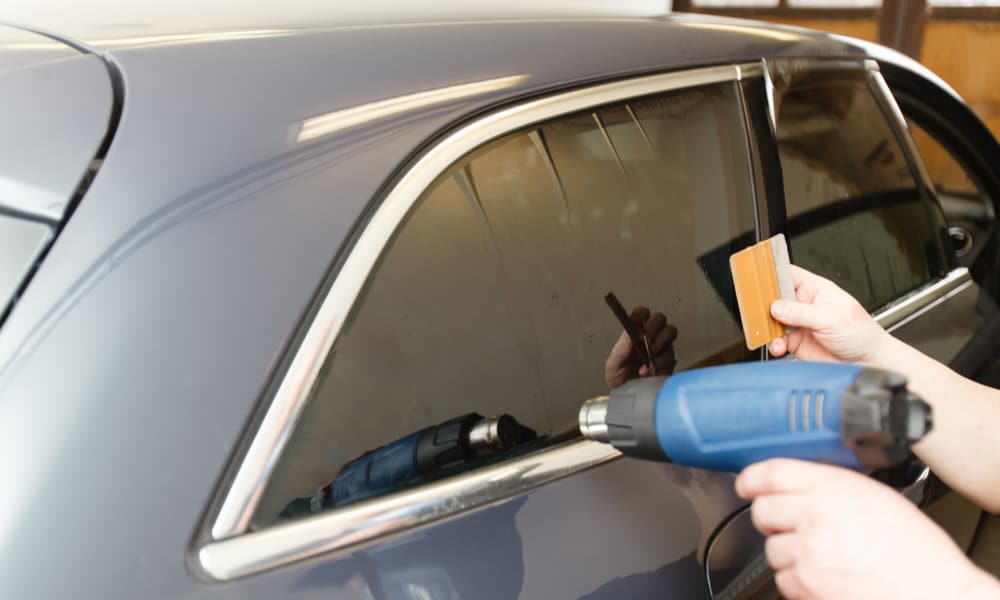Although factory tinted glass and aftermarket tint may be similar in appearance, the materials, manufacturing procedures, and installation process are very different, giving window tint film additional benefits that factory tint does not provide.
Materials and Manufacturing Process
The two tints are made from different materials and have a very different manufacturing process. Factory tinted glass contains pigments and dyes that are added to the glass during the manufacturing process. These dyes darken the color of the glass and reduce the amount of visible light that passes through the car’s window.

Window tinting refers to the process of applying a thin laminate film to a vehicle's glass in order to darken it. The reasons people choose to tint the windows of an automobile vary.
Aftermarket window tint is a polyester film comprised of multiple layers. This multi-layer construction includes an adhesive coating, layers containing metal particles, dyes and pigments, and a final layer that provides scratch-resistant protection the film. Different types and quantities of metals added to the internal layers impact the tint’s color, light transference and reflective properties of the film.
- Advanced Glass Tinting. Window Tinting Glass Coating & Tinting Glass-Auto, Plate, Window, Etc.
- When people think of tinting their windows, most often, their minds will go to vehicles. However, one of the most advantageous uses of window tinting is for homes, not cars. Window tinting refers to the process of applying a transparent sheet of film to glass. Home Window Tinting Pros.
Tinted Windows Cvc
Aftermarket Tint Installation
Tinted Windows Legal Limit
Because the dyes and pigments are inside glass with factory tint, there are no installation procedures after the window is manufactured and installed in the vehicle. The same cannot be said for aftermarket tinted film, which will be applied to the interior surface the vehicle’s windows after the car has been manufactured and sold.

The film is first cut to match the dimensions of the vehicle’s windows. The interior side of the glass is cleaned to ensure that no dirt or dust particles will be trapped under the film, and then solvents are sprayed onto the glass. These solvents react with the adhesive coating on the film, allowing the installer to move the film into place before the adhesive cures.
Tinted Windows
Automotive Window Tint Removal
Tinted Windows For Cars
It is not possible to remove factory tint from a car window. This is because the dyes and pigments are mixed inside the glass. Aftermarket tinting film can be removed from the glass by using tools to peel the film and solvents to breakdown the adhesive coating.
For best results, work with window tinting professional. Although tint installation and removal can be a project for do-it-yourselfers, automotive tinting companies have the ideal facilities, equipment chemicals for a professional result. These businesses also know and understand the laws for your state and will help you select a tint that meets your needs and satisfies the legal standard.
Protection from Ultra-Violet Rays & Solar Energy
Tinted Window Shades
To satisfy the broad spectrum on state tinting laws, factory tinted glass is typically placed in the rear windows of the vehicle this tint reduces the amount of visible light, it does not provide the same level of protection from ultraviolet rays as aftermarket tint. Adding window tint to both the front and rear windows of your vehicle reduces the volume of harmful UV rays that enter the car. This creates a safer environment for riders and reduces sun damage and fading of the car’s upholstery and dash.
Tinted Windows For Home
Aftermarket film also reflects and absorbs the sun’s solar energy from infrared light. When the sun’s energy goes unchecked, the temperature inside vehicle can drastically increase while the car sits idle in the sun. Factory tinted glass does little to reduce heat gain inside the vehicle, while aftermarket film maintains a more comfortable temperature inside the car.
Shattered Glass Protection
Although factory tinted glass is tempered and strengthened to increase durability, it provides little protection when the glass breaks. Typically resulting in pieces of broken glass flying into the vehicle during an accident or break-in. On the other hand, the adhesive and protective layers of aftermarket window film work to hold broken glass in place, reducing the chances of bodily injury for passengers.
